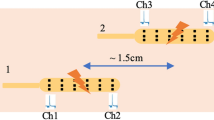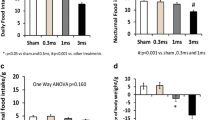Abstract
Purpose
This study aimed to compare the effects of colonic electrical stimulation (CES) on gastrointestinal transit time (GITT), energy consumption, stool frequency, stool consistency, and food intake using different individual parameter patterns and stimulation sites.
Methods
Eight beagle dogs underwent surgery and CES. First, CES was conducted to determine the individual parameters with different pulse configurations, based on symptoms. Second, influences on energy consumption and GITT were compared between CES sessions with different pulse configurations. Third, GITT, stool frequency, stool consistency, and food intake were compared to assess the effects of CES at different stimulation sites.
Results
The individual parameters varied greatly among the dogs. In proximal colon electrical stimulation (PCES) and rectosigmoid colon electrical stimulation (RCES), energy consumption was lower with the constant pulse width mode than with the constant pulse amplitude mode (p = 0.012 and p = 0.018, respectively). There was no statistical difference between the two pulse configurations in GITT assessment. The PCES, RCES, and sequential CES sessions significantly accelerated GITT compared to sham stimulation. There was no statistical difference in GITT between PCES, RCES, and sequential CES sessions. Compared to sham CES session, RCES and sequential CES sessions exhibited significant higher stool frequency (p < 0.001 and p = 0.001, respectively), and PCES and RCES sessions inhibited food intake (p = 0.003 and p = 0.002, respectively).
Conclusions
Constant pulse width mode is an appropriate pulse configuration for individual CES. At different stimulation sites, CES may exert different effects on stool frequency and food intake. This study provides an experimental basis for the clinical application of CES.





Similar content being viewed by others
References
Lin Z, Sarosiek I, McCallum RW (2007) Gastrointestinal electrical stimulation for treatment of gastrointestinal disorders: gastroparesis, obesity, fecal incontinence, and constipation. Gastroenterol Clin N Am 36(3):713–734, x-xi
Hasler WL (2009) Methods of gastric electrical stimulation and pacing: a review of their benefits and mechanisms of action in gastroparesis and obesity. Neurogastroenterol Motil 21(3):229–243
Sevcencu C (2006) Electrical stimulation— an evolving concept in the treatment of colonic motor dysfunctions. Neurogastroenterol Motil 18(11):960–970
Shafik A, El-Sibai O, Shafik AA, Ahmed I (2003) Colonic pacing in the treatment of patients with irritable bowel syndrome: technique and results. Front Biosci 8:b1–b5
Shafik A, El-Sibai O, Shafik AA, Ahmed I (2004) Electric activity of the colon in irritable bowel syndrome: the ‘tachyarrhythmic’ electric pattern. J Gastroenterol Hepatol 19(2):205–210
Liu S, Lei Y, Chen JD (2006) Inhibitory effects and mechanisms of colonic electric stimulation on gastric and rectal tone in conscious dogs. Dis Colon Rectum 49(11):1749–1754
Sun Y, Chen J (2004) Intestinal electric stimulation decreases fat absorption in rats: therapeutic potential for obesity. Obes Res 12(8):1235–1242
Sallam HS, Chen JD (2013) Colonic electrical stimulation: potential use for treatment of delayed colonic transit. Color Dis 15(5):e244–e249
Liu S, Chen JD (2006) Colonic electrical stimulation regulates colonic transit via the nitrergic pathway in rats. Dig Dis Sci 51(3):502–505
Aellen S, Wiesel PH, Gardaz JP, Schlageter V, Bertschi M, Virag N et al (2009) Electrical stimulation induces propagated colonic contractions in an experimental model. Br J Surg 96(2):214–220
Vaucher J, Cerantola Y, Gie O, Letovanec I, Virag N, Demartines N et al (2010) Electrical colonic stimulation reduces mean transit time in a porcine model. Neurogastroenterol Motil 22(1):88–92, e31
Shafik A, El-Sibai O, Shafik AA (2000) Rectal pacing in patients with constipation due to rectal inertia: technique and results. Int J Color Dis 15(2):100–104
Amaris MA, Rashev PZ, Mintchev MP, Bowes KL (2002) Microprocessor controlled movement of solid colonic content using sequential neural electrical stimulation. Gut 50(4):475–479
Sanmiguel CP, Casillas S, Senagore A, Mintchev MP, Soffer EE (2006) Neural gastrointestinal electrical stimulation enhances colonic motility in a chronic canine model of delayed colonic transit. Neurogastroenterol Motil 18(8):647–653
Martellucci J, Valeri A (2014) Colonic electrical stimulation for the treatment of slow-transit constipation: a preliminary pilot study. Surg Endosc 28(2):691–697
Zhang Y, Du S, Fang L, Yao S, Chen JD (2014) Retrograde gastric electrical stimulation suppresses calorie intake in obese subjects. Obesity (Silver Spring) 22(6):1447–1451
Li Y, Yao S, Chen S, Zhang Y, Guo X, Zhang W et al (2014) The acute effects of a new type of implantable gastric electrical stimulators featuring varied pulse widths on beagle dogs’ food intake and gastric accommodation. Obes Surg 24(5):783–790
O’Donnell LJ, Virjee J, Heaton KW (1990) Detection of pseudodiarrhoea by simple clinical assessment of intestinal transit rate. BMJ 300(6722):439–440
Hughes SF, Scott SM, Pilot MA, Williams NS (1995) Electrically stimulated colonic reservoir for total anorectal reconstruction. Br J Surg 82(10):1321–1326
Zhu B, Wang Y, Yan G, Jiang P, Liu Z (2014) A gastrointestinal electrical stimulation system based on transcutaneous power transmission technology. Gastroenterol Res Pract 2014:728572
Shafik A, Shafik AA, El-Sibai O, Ahmed I (2004) Colonic pacing: a therapeutic option for the treatment of constipation due to total colonic inertia. Arch Surg 139(7):775–779
Shafik A (1994) Study of the electrical and mechanical activity of the rectum: an experimental study. Eur Surg Res 26(2):87–93
Shafik A (1996) Sigmoido-rectal junction reflex: role in the defecation mechanism. Clin Anat 9(6):391–394
Shafik A (1998) Rectosigmoid junction: anatomical and physiological considerations with identification of rectosigmoid pacemaker and sigmoidorectal junction reflex and the role in constipation and incontinence. Coloproctology 20(2):45–57
Xu X, Lei Y, Chen JD (2010) Effects and mechanisms of electrical stimulation of the stomach, duodenum, ileum, and colon on gastric tone in dogs. Dig Dis Sci 55(4):895–901
Sallam HS, Chen JD (2011) Colon electrical stimulation: potential use for treatment of obesity. Obesity (Silver Spring) 19(9):1761–1767
Sevcencu C, Rijkhoff NJ, Sinkjaer T (2005) Colon emptying induced by sequential electrical stimulation in rats. IEEE Trans Neural Syst Rehabil Eng 13(4):516–523
Sevcencu C, Rijkhoff NJ, Gregersen H, Sinkjaer T (2005) Propulsive activity induced by sequential electrical stimulation in the descending colon of the pig. Neurogastroenterol Motil 17(3):376–387
De Luca M, Segato G, Busetto L, Favretti F, Aigner F, Weiss H et al (2004) Progress in implantable gastric stimulation: summary of results of the European multi-center study. Obes Res 14(Suppl 1):S33–S39
Guo X, Li Y, Yao S, Chen S, Du Y, Wang Z (2014) Parameter selection and stimulating effects of an adjustable gastric electrical stimulator in dogs. Obes Surg 24(1):78–84
Acknowledgments
This work was supported by the National High-tech R&D Program (863 Program) (grant no. 2012AA021104) and the National Natural Science Foundation of China (grant no. 81070299).
Author information
Authors and Affiliations
Corresponding authors
Ethics declarations
All procedures performed in this study were in accordance with the ethical standards of the China–Japan Friendship Hospital (Beijing, China).
Conflict of interest
The authors declared no conflict of interest.
Rights and permissions
About this article
Cite this article
Chen, S., Liu, L., Guo, X. et al. Effects of colonic electrical stimulation using different individual parameter patterns and stimulation sites on gastrointestinal transit time, defecation, and food intake. Int J Colorectal Dis 31, 429–437 (2016). https://doi.org/10.1007/s00384-015-2457-6
Accepted:
Published:
Issue Date:
DOI: https://doi.org/10.1007/s00384-015-2457-6




